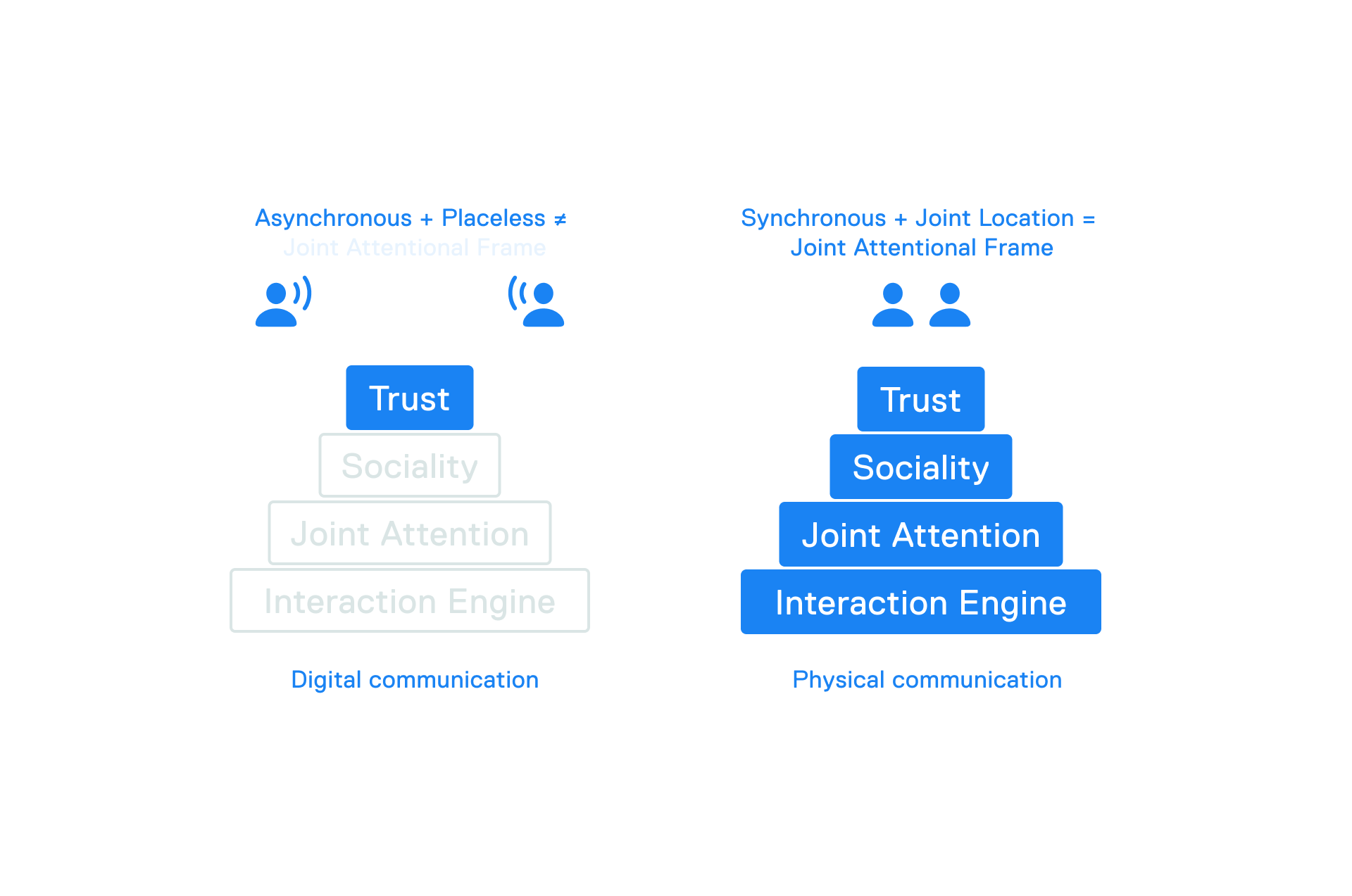For Who? Locating trust and novel forms of sharing.
Judd Smith

 For Who? Locating trust and novel forms of sharing.
For Who? Locating trust and novel forms of sharing.
This is a mobile navigation device that creates a local index of your communities favorite places, allowing you to focus on the people and place in front of you. This ecosystem is compatible with everywhere you save, compile & sort ‘place’ you and your friends data into one clean “Communal Place”.
 Stephen Levinson’s work on the Human Interaction Engine attributes three properties of Human social interaction: The attribution of intention through behavior mapping onto goals, mutual salience or common ground—necessary for cooperative interaction, and intentions that drive behavior solely effected by virtue. Because technology and tools become an extension of our cognition, it is important to explore and create new configurations of sensors and rulesets to afford a different texture of presence that preserves the elements of our human sociality. This is a socially oriented practice, which aims to create new social structures and scaffolding for more authentic relations than incumbent digital systems do. This practice blends both commercial use-case with grassroots rapid prototyping of different protocols for organizing communities.
Stephen Levinson’s work on the Human Interaction Engine attributes three properties of Human social interaction: The attribution of intention through behavior mapping onto goals, mutual salience or common ground—necessary for cooperative interaction, and intentions that drive behavior solely effected by virtue. Because technology and tools become an extension of our cognition, it is important to explore and create new configurations of sensors and rulesets to afford a different texture of presence that preserves the elements of our human sociality. This is a socially oriented practice, which aims to create new social structures and scaffolding for more authentic relations than incumbent digital systems do. This practice blends both commercial use-case with grassroots rapid prototyping of different protocols for organizing communities.
 Precedents
Precedents
There have been a number of precedents, either full reduced affordance provocations, or companion device consumer hardware for different use-cases. Take SUSA for ASUS for example, a device that aims to suggest how AI could be used to shift how we interact with certain digital devices to create a more intuitive, tactile and less distracting experience. Our project provides a tangible intermediate step to approaching the idea of new mobile computation methods through positioning an commercially-viable use-case for reducing our time spent on device in a social and navigational context, without throwing out all of the other useful functions and use-cases we hire our phones to complete in our everyday lives. Or consider FOAM, an open source protocol that is a radio-based network of zones to provide location services for Web3 applications. Proof of Location is a critical prerequisite for the further development of Web3 use cases. Our project seeks to verify and acknowledge the physical exchange of information through a combination of NFC physical proximity verified transacting of information, and possibly geo-location / directional verification process (i.e. “walk 2 meters in the direction of Rome, verified by your geo-location and heading) to establish and preserve the physical aspect of the formations of our networks.

Audience
According to the Carson College of Business’ 2024 American Travel Survey, over a third of Gen Z (38%) and Millennials (34%) expect to spend “a lot of time” comparing costs of travel destinations and activities the next time they travel. Gen Z — 20.2% of the U.S. population and about 32% of the global population— heavily relies on technology, including Tiktok and Instagram for travel inspiration,AI-generated itineraries and mobile apps, for planning and booking their trips. Mental health and wellness are important travel motivators, as 93% report that travel positively impacts their well-being. Millennials—represent about 22% of the U.S. population and constitute 27% of the global population (around 2 billion people), travel more than any other demographic, averaging 35 days of vacation per year. Millennials prioritize experiences over material goods, seeking authenticity, fulfillment, and sustainability in their travel choices.
Let's go on a walk:
“I’m finishing up a big meeting near Union Square early and have a few hours to kill before my evening
I want to walk around the city for a bit to get a feel for lower Manhattan, but I’m pretty hungry”
“I turn on my device, and check my recommendations”
“There’s a cute bar near me Will told me a while back, a Thai spot my friend Marquia shared right before this trip, and a cool Gallery I’ve heard Eugene talk about. but right now, I’m hungry for Thai, so lets go with Marquia’s suggestion.”
“My device nudges me in the right direction, allowing me to be present where I am. My walk’s pretty manageable and the haptics alerts me of where I need to go without always having to check my device.”
“There’s so many cute spots in this part of town I’ve never seen before. I usually walk around here too when I’m in New York.”Interruption:“I see a cute spot on the corner, my device alerts me is “Salvos” after lingering outside for a minute
 My friend Marquia who’s in New York, gets a notification.
My friend Marquia who’s in New York, gets a notification.
“A diner told me about a great spot down the road I want to check out for later, we exchange places and I’m gonna see what that’s about later.”
On Future,
What if we reclaimed our sociality and relied on horizontal relational knowledge to see the world? Just as Language shapes culture and culture shapes thought, Our technology shapes our cognition which shapes our thoughts. Computational advancements in recent years increasingly afford the ability for ambient computation, so lets put people first. If trust and meaning is contextualized by the people around us and pro-social communication, and the ability to establish and sustain joint attention constitute some of the basic building blocks of intersubjectivity, then lets flatten the dimensions of technology to afford us to focus on the thing that matters most: People.
Work Cited
Enfield, N. J., and Stephen C. Levinson, editors. Roots of Human Sociality: Culture, Cognition, and Interaction. Berg, 2006.
Gibson, James J. The Ecological Approach to Visual Perception. Houghton Mifflin, 1979.
Acheulean technology and emergent sociality
Edwards, Terra. "Re-Channeling Language: The Mutual Restructuring of Language and Infrastructure among DeafBlind People at Gallaudet University." Protactile Research Network, 2014
U.S. Census Bureau: U.S. Census Bureau. (2020). Age and sex composition in the United States: 2020. https://www.census.gov/data.html
TravelPerk. (2024, February 19). 30+ Gen Z travel statistics and trends [2024 update]. https://www.travelperk.com
TimeOut. (2024, February 8). These are Gen Z's top travel trends in 2024. https://www.timeout.com/usa/news/these-are-gen-zs-top-travel-trends-in-2024-020824
World Economic Forum. (2021, November 18). Millennials: A regional breakdown of the world’s largest adult generation. World Economic Forum. https://www.weforum.org/agenda/2021/11/millennials-world-regional-breakdown/